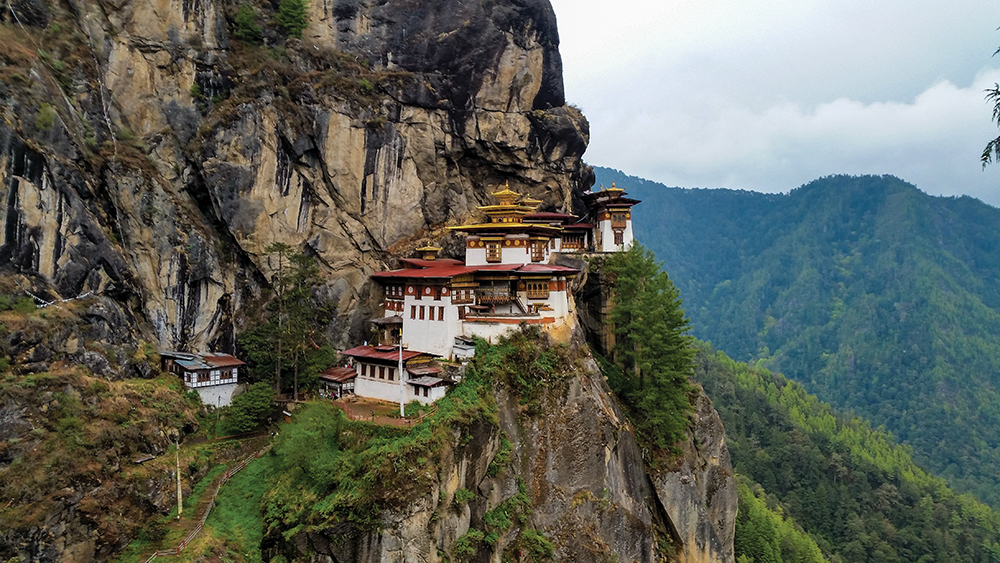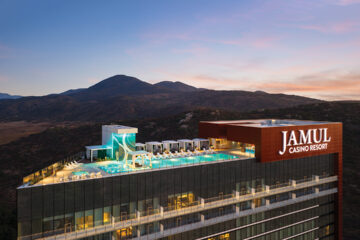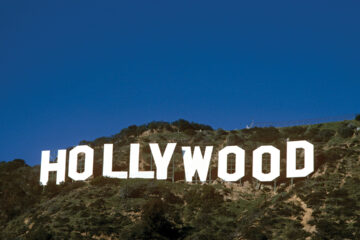Finding Happiness in Beautiful Bhutan

Finding Happiness in Beautiful Bhutan
Posted on July 26, 2017
My fascination with the Kingdom of Bhutan started with a Time magazine article in 2008. “The king declared that the nation should become a democracy, and his subjects were horrified,” I read. It seems that, after a century of royal rule, most Bhutanese were afraid that a new form of government might weaken their beloved cultural traditions. Paramount among these is the policy of “Gross National Happiness,” which measures the success of the country by how content, healthy, and well educated people are, as well as the state of the environment and strength of the culture.
The article piqued my curiosity and when I looked for more information, I learned that Bhutan is located in the Himalayas between India and China; is about the same geographic size as Switzerland (population 7 million); and is home to about 750,000 people — 80 percent of whom are Buddhist. The Land of the Thunder Dragon, as it is known, was almost completely isolated until the 1970s when it joined the United Nations and admitted the first overseas visitors.
Gross National Happiness? Bhutan immediately zoomed to the top of my bucket list, but all attempts to plan a trip were thwarted. The king and nascent elected government allowed only carefully-managed groups of visitors and that just didn’t appeal to me. Over the years, I ogled pictures of the gorgeous Himalayan countryside festooned with colorful prayer flags, but stubbornly resisted joining a tour.
However, fate intervened last year when I met Matt Holmes, president and founder of Boundless Journeys, a top-notch travel company based in Vermont. In spite of the fact that they are known for their award-winning group tours to Bhutan, I pleaded my case and was pleasantly surprised when he offered to craft a custom trip for my husband and me. “The Hansen – Adams Tour will be limited to two people,” he assured me.

High-Value, Low-Volume Tourism
Ashley Nesbitt, Matt’s Bhutan specialist, helped me plan the trip. She also explained that in order to reduce the impact of tourism and preserve the local culture, the government limits the number of visitors and requires that even those on custom tours be accompanied by a guide. In addition, a set fee (currently $250 per person per day, $200 off-season) must be pre-paid before a coveted Bhutanese visa is issued. The fee covers 3-star accommodations, all meals, a licensed guide, and ground transportation within the country. It also includes a sustainable development fee of $65, which supports free education, free healthcare, poverty alleviation, and the building of infrastructure.
Nesbitt also pointed out that, in addition to basic lodgings, Bhutan is home to some wonderful 5-star properties. The best of these are the five Amankora lodges that offer the exclusive luxury and attention to detail that has earned Aman its worldwide “6-star” reputation. Como Hotels and Resorts, Taj Hotels, and several local companies also operate deluxe hotels throughout the country. All visitors have the option of upgrading from 3-star to 4- or 5-star places at a considerable (but worth it) surcharge.

Our Wonderful Whirlwind
When our flight arrived in Paro, I witnessed something I’d never seen before. Rather than rush to be at the head of the queue for customs and immigration, deplaning passengers stood on the tarmac and took in the view. The lush green valley the pilot had just skillfully navigated, the Himalayas in the distance, and the folk art and royal family portrait painted on the terminal buildings were all simply stunning. I wasn’t the only one with tears in my eyes.
This somewhat spellbound feeling persisted throughout our 12-day stay. I love to walk, but since I live at sea level, I don’t exactly excel at steep climbs. And yet, in Bhutan, I frequently found myself enjoying the view from mountaintop monasteries. One day, as we made our way uphill to a temple in Punakha, my husband, Richard (a man not known for poetic comments), looked out over the view of farmland, rivers, and forest, and said, “If this isn’t Shangri-La, I don’t know what is.”
We hiked a lot, in part because it was the only way to access some of the beautiful Buddhist temples, fortresses (dzongs), and monasteries for which the country is famous. I didn’t realize it at the time, but Nesbitt had planned our itinerary so that the climbs became a bit more difficult as our journey progressed. This strategy led to one of the highlights of the trip: hiking to Tiger’s Nest Monastery near Paro. Bhutan’s most recognized landmark is located at an elevation of about 10,000 feet and the trail is rocky and steep, so there were high fives all around when we reached the top.

Another highlight was rafting the turquoise river that flows in front of the historic dzong in Punakha. It was May and the jacaranda trees were in full bloom, just as they are in spring in San Diego.

In Bumthang, the cultural heart of the country, we enjoyed a delicious lunch sitting on the floor of a farmhouse. Our host made some of my favorite Bhutanese foods, including buckwheat noodles with fresh coriander and sautéed fiddlehead ferns. Later, I discovered I like yak meat, which I enjoyed on yak sausage pizza at Amankora Bumthang, and again served grilled with local vegetables at the gorgeous Gangtey Lodge.
Traveling around the country, I never tired of the graceful landscape that ranged from forests of blue pines to stands of red rhododendrons to fields of wild mustard. I also loved views of snow-capped mountains and the heart-tugging prayer flags that fluttered in the wind on high passes.

When I asked people why they were happy, one explained, “Because the king takes care of us. He walks around the country asking what we need. He even asked the nomadic yak herders in the Himalayas, and when they said they wanted to be able to use their smartphones, he moved the cell towers higher on the mountains.”
So, it seems that perhaps the only unhappy people in Bhutan are departing overseas visitors. Elizabeth Hansen

Best Places to Stay and Dine
We loved our time at the Aman hotel in the Bumthang district. Set on the palace grounds of Bhutan’s second king, the chic property offers 16 spacious rooms, a library, and cozy seating around a fire pit in the courtyard. There’s also a spa where we enjoyed “Zen” massages. The charming staff pampers guests with in-suite tea service, evening cultural programs, and farewell blessings by a resident monk.
As is typical throughout Bhutan, the menu here includes Bhutanese, Indian, and Western dishes. At breakfast I enjoyed buckwheat crepes made with “backyard” scrambled eggs, Tasso ham, and Bumthang Valley cheese. I also loved the freshly-baked rhubarb scones and was very excited to see lassi, the popular Indian yogurt beverage, on the menu. My favorite lunch was yak sausage pizza.
Aman operates five Amankora lodges in Bhutan. They are located in Bumthang, Gangtey, Paro, Thimphu, and Punakha.
Gangtey Lodge was another wonderful place we thoroughly enjoyed. Here, the magnificent great room with a huge fireplace and fieldstone walls reminded me of the best U.S. national park lodges. This handsome space is perfect for dining, drinking, and gazing at the panorama of nearby pastoral valleys and tree-clad mountains in the distance. All 12 spacious rooms offer cozy fireplaces and large bathtubs in front of picture windows.

The dining experience at Gangtey Lodge is orchestrated by Soh Chia Hwa, a talented Malaysian chef who has worked all over the world. She makes everything from scratch with local ingredients. Her grilled yak dinner with just-picked vegetables was wonderful. I also enjoyed her flavorful tofu veggie stir fry. And, while it isn’t Bhutanese, I thought her chocolate lava cake was heavenly.
Thoughts on other hotels:
Our room at Uma Como, Paro was smallish, but this luxury property does have one of the few swimming pools in the country (indoor). We enjoyed dining at Bukhari and the staff was great. Prince William and Kate Middleton stayed at Uma Como, Paro last year. There’s another Uma Como in Punakha.
I loved the traditional artwork that is found throughout Nak-Sel Boutique Hotel in Paro — and also the fact that our large room offered a view (albeit distant) of Tiger’s Nest Monastery.

In Punakha we stayed at Dhensa Boutique Hotel, which is new and very contemporary. It’s on the slope of a mountain that provides scenic views to a river below. We didn’t have great dining experiences at Dhensa.
All of the hotels described here require a surcharge ranging from $370 to $1,595 a night for lodging and meals for two people. I can’t recommend the one hotel we didn’t upgrade — the Druk in Thimphu. In hindsight, the Taj Tashi would have been a better choice.
Restaurants:
In addition to hotel meals, it was fun to try local restaurants. We enjoyed Chh’a in Thimphu, but my very favorite was ZaSa, where we ate lunch after a big hike up to Cheri Monastery outside of Thimphu. Our meal included amazing pumpkin soup, sautéed local mushrooms, traditional red rice, yummy bok choy with tofu, plus delicious pork and fish dishes. And for dessert, apple crumble with warm custard and pomegranate seeds.
Top ten surprising things about Bhutan:
- Children are named by local monks, not their parents, and most names are unisex. “Pema” could be a boy or a girl.
- Birth certificates have only been issued for the past 25 years or so. Consequently many people don’t know their birthday or even the year.
- Dzongkha is the local language, but all formal instruction is in English, so even young school kids are bilingual.
- Bhutanese have profound respect for the environment. The constitution requires that no less than 65 percent of the country remain forested. Currently 70 percent is covered in trees, which contributes to the country being carbon negative.
- The tallest unclimbed mountain in the world is in Bhutan (because climbing it would be disrespectful).
- Roadsides are free of litter and billboards, and commercial signage in towns and villages is standardized.
- We never saw buildings defaced with graffiti. Instead, we admired the folk art that decorates the exterior of most homes.
- There are no stoplights in the country. A few years ago, one was installed in Thimphu, the capital, but the people didn’t like it, so it was removed the next day.
- Bhutan’s main income comes from selling hydro-electric power to India.
- Archery is Bhutan’s national sport. The most popular bows are made by Hoyt in the U.S.

Amankora: Photo courtesy of Amankora Prayer Flags: Photo Courtesy of Boundless Journeys All other Photography Courtesy of ADAMS / HANSEN STOCK PHOTOS







Two Comments
sandy sathya
Travelrdestiny make you the best traveling experience, leading you giving the confidence of seeing the world within your time.
JOHNNY JET
Amazing place! Thanks for sharing